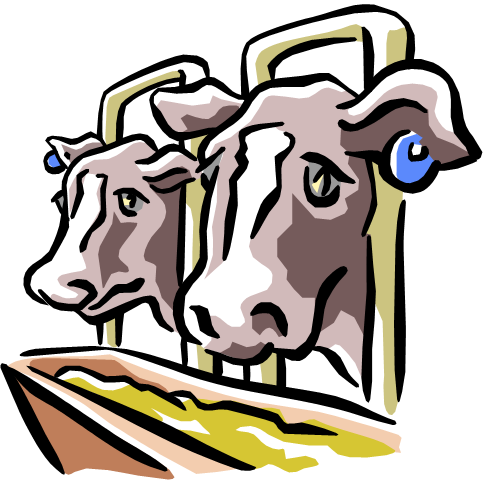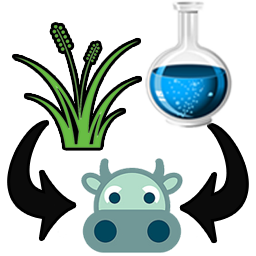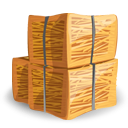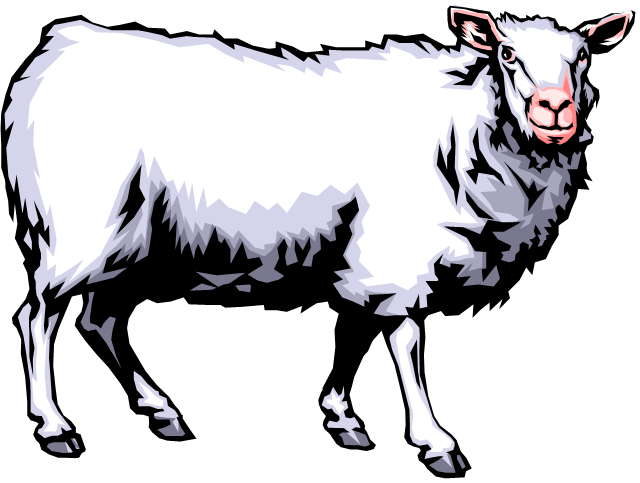 |
 |
The Ruminant Nutrition System (RNS) is a comprehensive nutrition model that integrates cattle, sheep and goats into one platform. The RNS was developed to provide a framework that can be used for incorporating and implementing new scientific knowledge and submodels to more accurately predict nutrient requirements and biological values for ruminants currently used in food production. The RNS has a modern design and interface that uses an integrated object-oriented programming approach to allow for quicker and customized simulations. The RNS structure permits power users to expand their simulation routines through the R script programming. |
| Click here to go to the RNS web page |
|
 Top
Top
 |
 |
The Large Ruminant Nutrition System (LRNS) is a computer program that estimates beef and dairy cattle requirements and nutrient supply under specific conditions of animal type, environment (climatic factors), management, and physicochemical composition of available feeds, using the computational engine of the Cornell Net Carbohydrate and Protein System (CNCPS) model as published by Fox et al. (2004). |
| Click here to go to the LRNS web page |
|
 Top
Top
 Top
Top
 Top
Top
 |
 |
The Beef Cattle Nutrient Requirements Model by the National Research Council (NRC, 1996, 2000) version 1.0.3 can be downloaded here. The Beef NRC (1996, 2000) software was originally developed for Microsoft Disk Operating System (MS-DOS) or Personal Computer Disk Operating System (PC-DOS) of Intel x86 computers. Unfortunately, the software is incompatible with newer operating systems, such as Microsoft Windows XP, Windows Vista, Windows 7, and Windows 8, running on either 32-bit or 64-bit machines. Under the auspices of the National Animal Nutrition Program, the Modeling Committee of the National Research Support Project (NRSP-9) used DOSBox to allow users to continue using the Beef NRC (1996, 2000) software in modern computers and operational systems. |
| Click here to read the modifications in the Beef NRC (1996, 2000) |
|
 Top
Top
 |
 |
The Dairy Cattle Nutrient Requirements Model by the National Research Council (NRC, 2001) version 1.1.10 can be downloaded here. The Dairy NRC (2001) software was developed using Microsoft Visual Basic 6. Under the auspices of the National Animal Nutrition Program, the Modeling Committee of the National Research Support Project (NRSP-9) performed several fixes in the original software to allow users to continue using the Dairy NRC (2001) software in modern computers and operational systems. |
| Click here to read the modifications in the Dairy NRC (2001) |
|
 Top
Top
 |
 |
The Modelo de Composição Corporal de Gado de Corte (MCCGC: Beef Cattle Body Composition Model) was developed to simulate body and gain compositions of growing beef cattle based on the growth model developed by Keele et al. (1992) and Williams et al. (1992). The model allows users to evaluate the impact of different plane of nutrition on the composition of the gain that are not associated with changes in empty body weight. This computer program was originally developed in Portuguese using Visual Basic 4 in 1997, and revamped using Visual Basic 6 in 2019 and revised in 2023.
Previous versions can be downloaded from here. |

Current version of the MCCGC model is 1.1.2 |
|
 Top
Top
 |
 |
The Cattle Value Discovery System (CVDS) was developed for use in individual cattle management for growing beef cattle. The CVDS provides (1) prediction of daily gain, incremental cost of gain and days
to finish to optimize profits and marketing decisions while marketing
within the window of acceptable carcass weights and composition, (2) predictions of carcass composition during growth to avoid discounts for under or over weight carcasses
and excess backfat, and (3) allocation of feed fed to pens to individual animals for the purpose
of sorting of individuals into pens by days to reach target body composition
and maximum individual profitability. |
| Click here to go to the CVDS web page |
|
 Top
Top
Model Evaluation and Adequacy |
 |
 |
The Model Evaluation System (MES) was developed to assist on the adequate evaluation of mathematical models using statistical analysis, including linear regression analysis, mean square error of the prediction, concordance correlation coefficient, distribution analysis, deviation analysis, graphics and histogram, robust statistics, etc. |
| Click here to go to the MES web page |
|
 Top
Top
 |
 |
The Gamma Distribution-like Degradation and Passage Models (GnG1) was developed based on theoretical concepts and probability to generalize the rumen processes of fiber digestion, assuming a gamma distribution. It can be used to interpret fiber degradation and passage profiles. The GnG1 model was evaluated for quality of fit using in vitro fiber degradation profiles and in vivo fiber passage profiles. The integration of digestion and passage is based on the concept that fibrous digesta in the rumen is heterogeneous (Vieira et al., 2007a,b,c). |
| Click here to go to the GnG1 web page |
|
 Top
Top
 |
 |
The in vitro gas production technique has been frequently used to assess biological values of feeds based on their pattern of accumulated gas during incubation with rumen fluid under anaerobic conditions. After data is collected, kinetic parameters that accurately describe the pattern of fermentation can be obtained. Several models have been described and used to fit in vitro gas production data to nonlinear functions (López et al., 1999). The GasFit System was developed to evaluate several nonlinear models in fitting gas production data. |
| Click here to go to the GasFit web page |
|
 Top
Top
 |
 |
A mechanistic model is presented to adjust the fractional rate of fermentation of available fiber based on the estimate of unavailable fiber and the computed theoretical unavailable fiber using lignin content. The object of this computer program is to generate a system by which values for rate of digestion and its retardation can be predicted and used in the field. At the present time there is no system for deriving digestion rates apart from those in the feed dictionary. Analytical values available in the field, include NDF, ADF, lignin, crude protein (CP) and sometimes in vitro digestibility at 24 or 30 h. Rates of digestion and DU will need to be predicted from these observations. |
| Click here to go to the NDF kd web page |
|
 Top
Top
 |
 |
The Meal Criterion Calculation (MCC) software was designed to analyze cattle feeding behavior data collected by the GrowSafe System to compute feedbunk visit interval (BVI) and meal criterion (MC). MC is the longest non-feeding time that defines a meal. It is calculated as the intersection of two distributions: the non-feeding time within a meal and the non-feeding time between meals. MCC works with different distribution forms (normal, gamma, log-normal, Weibull) and unlimited number of animals and data records. |
Click here to go to the MCC web page |
|
 Top
Top
 |
 |
The Hay Game is a stand-alone computer software based on the Beer Game. The Beer Game was developed to introduce students, managers, and executives to concepts of system dynamics. The purpose of the game is to illustrate the key principle that "structure produces behavior." Players of the Hay Game experience system complexity and provides insights of the long-term effects during the course of the game. The objective of the Hay Game is to minimize the total cost of hay utilization in a farm. |
| Click here to go to the Hay Game web page |
|
 Top
Top
 |
 |
Nim is a classical, simple game of logic and strategy, but with finite possibilities. The rule is that you may remove as many matches within a row in one move. The looser is who removes the last match on the table. There are several variations of the Nim game, including different objects, rules (winner is the one that removes the last object), number of rows of objects, max number of objects that can be removed at a time, and amount of objects.
Previous versions can be downloaded from here. |

Current version of the Nim Game is 1.9.1.0 |
|
 Top
Top
Commonly used modeling terminology can be found here.














